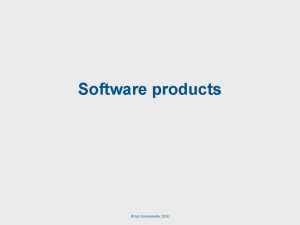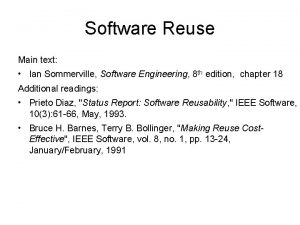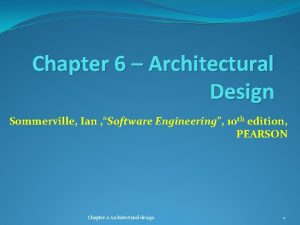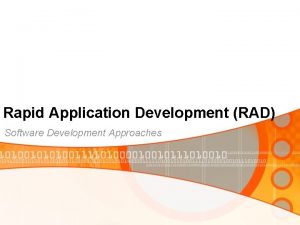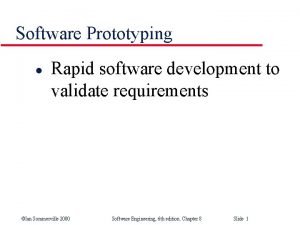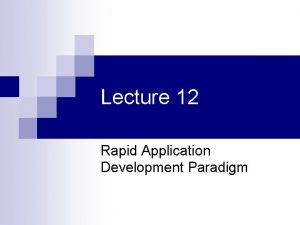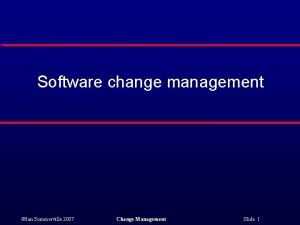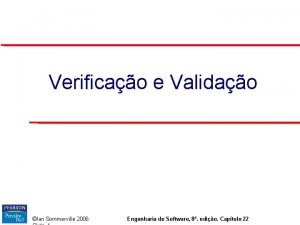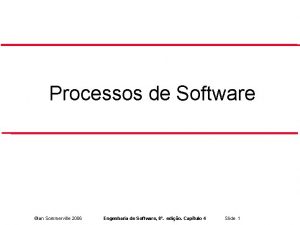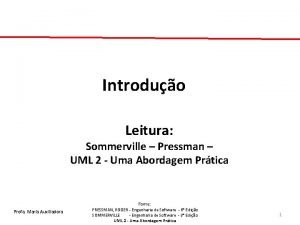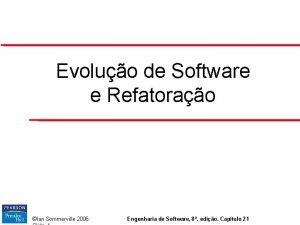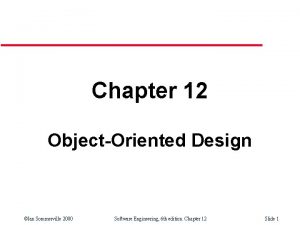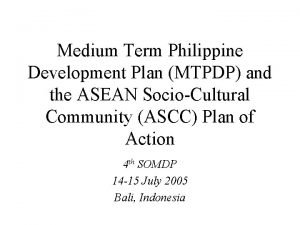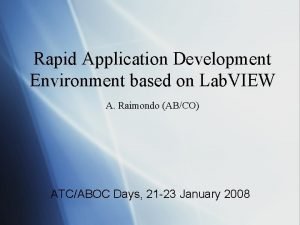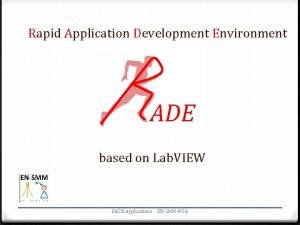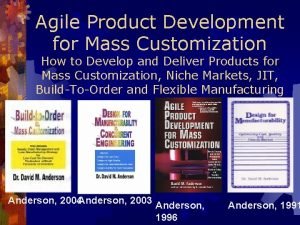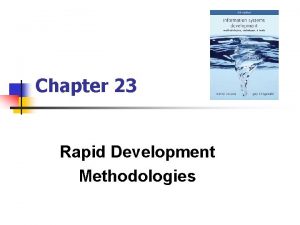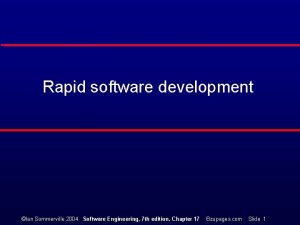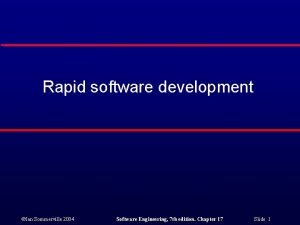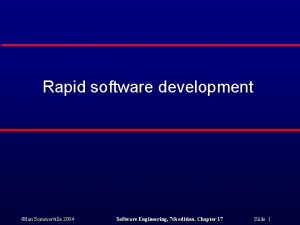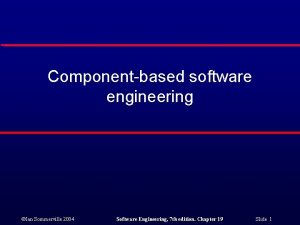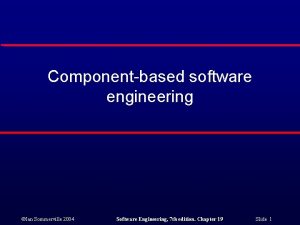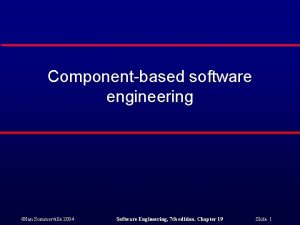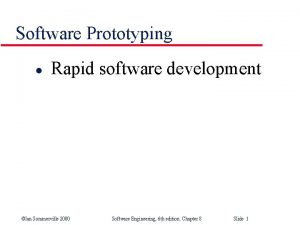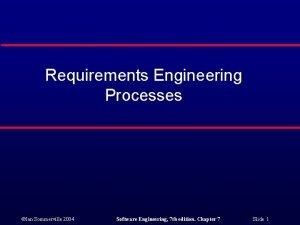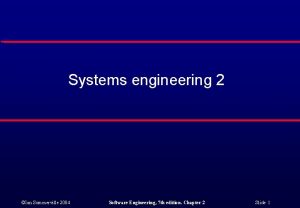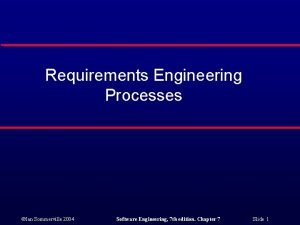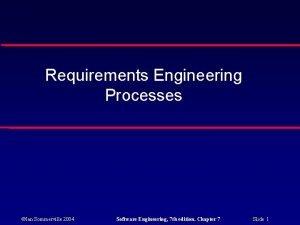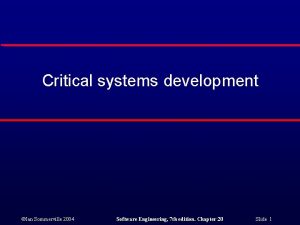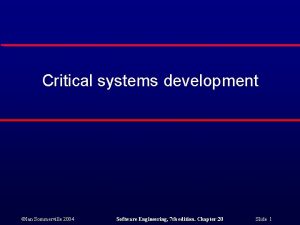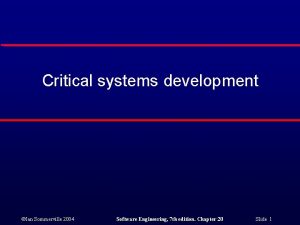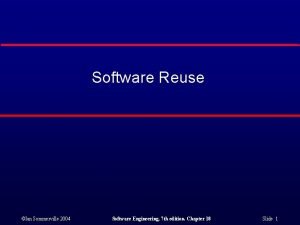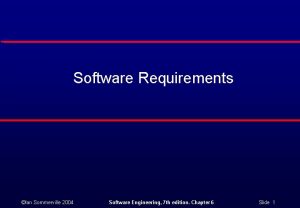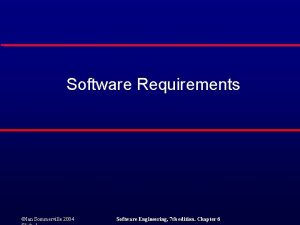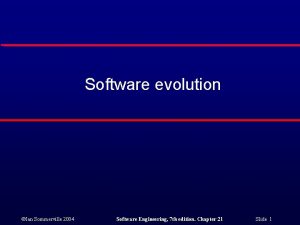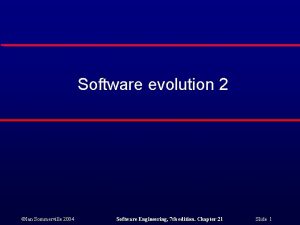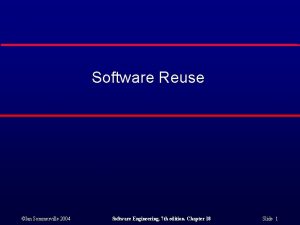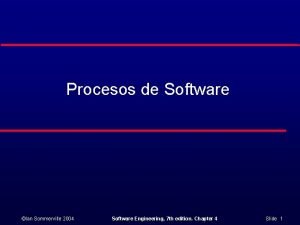Rapid software development Ian Sommerville 2004 Software Engineering

























- Slides: 25

Rapid software development ©Ian Sommerville 2004 Software Engineering, 7 th edition. Chapter 17 Slide 1

Objectives l l To explain how an iterative, incremental development process leads to faster delivery of more useful software To discuss the essence of agile development methods To explain the roles of prototyping in the software process To explain the principles and practices of extreme programming (next lecture) ©Ian Sommerville 2004 Software Engineering, 7 th edition. Chapter 17 Slide 2

Rapid software development l l l Because of rapidly changing business environments, businesses have to respond to new opportunities and competition. This requires software and rapid development and delivery is not often the most critical requirement for software systems. Businesses may be willing to accept lower quality software if rapid delivery of essential functionality is possible. ©Ian Sommerville 2004 Software Engineering, 7 th edition. Chapter 17 Slide 3

Requirements l l Because of the changing environment, it is often impossible to arrive at a stable, consistent set of system requirements. Therefore a waterfall model of development is impractical and an approach to development based on iterative specification and delivery is the only way to deliver software quickly. ©Ian Sommerville 2004 Software Engineering, 7 th edition. Chapter 17 Slide 4

Characteristics of RAD processes l l l The processes of specification, design and implementation are concurrent. There is no detailed specification and design documentation is minimised. The system is developed in a series of increments. End users evaluate each increment and make proposals for later increments. System user interfaces are usually developed using an interactive development system. ©Ian Sommerville 2004 Software Engineering, 7 th edition. Chapter 17 Slide 5

An iterative development process ©Ian Sommerville 2004 Software Engineering, 7 th edition. Chapter 17 Slide 6

Advantages of incremental development l l Accelerated delivery of customer services. Each increment delivers the highest priority functionality to the customer. User engagement with the system. Users have to be involved in the development which means the system is more likely to meet their requirements and the users are more committed to the system. ©Ian Sommerville 2004 Software Engineering, 7 th edition. Chapter 17 Slide 7

Problems with incremental development l Management problems • l Contractual problems • l The normal contract may include a specification; without a specification, different forms of contract have to be used. Validation problems • l Progress can be hard to judge and problems hard to find because there is no documentation to demonstrate what has been done. Without a specification, what is the system being tested against? Maintenance problems • Continual change tends to corrupt software structure making it more expensive to change and evolve to meet new requirements. ©Ian Sommerville 2004 Software Engineering, 7 th edition. Chapter 17 Slide 8

Agile methods l Dissatisfaction with the overheads involved in design methods led to the creation of agile methods. These methods: • • • l Focus on the code rather than the design; Are based on an iterative approach to software development; Are intended to deliver working software quickly and evolve this quickly to meet changing requirements. Agile methods are probably best suited to small/medium-sized business systems or PC products. ©Ian Sommerville 2004 Software Engineering, 7 th edition. Chapter 17 Slide 9

Rapid application development l l Agile methods have received a lot of attention but other approaches to rapid application development have been used for many years. These are designed to develop dataintensive business applications and rely on programming and presenting information from a database. ©Ian Sommerville 2004 Software Engineering, 7 th edition. Chapter 17 Slide 10

RAD environment tools l l Database programming language Interface generator Links to office applications Report generators ©Ian Sommerville 2004 Software Engineering, 7 th edition. Chapter 17 Slide 11

A RAD environment ©Ian Sommerville 2004 Software Engineering, 7 th edition. Chapter 17 Slide 12

Interface generation l l Many applications are based around complex forms and developing these forms manually is a timeconsuming activity. RAD environments include support for screen generation including: • • • Interactive form definition using drag and drop techniques; Form linking where the sequence of forms to be presented is specified; Form verification where allowed ranges in form fields is defined. ©Ian Sommerville 2004 Software Engineering, 7 th edition. Chapter 17 Slide 13

Visual programming l l l Scripting languages such as Visual Basic support visual programming where the prototype is developed by creating a user interface from standard items and associating components with these items A large library of components exists to support this type of development These may be tailored to suit the specific application requirements ©Ian Sommerville 2004 Software Engineering, 7 th edition. Chapter 17 Slide 14

Visual programming with reuse ©Ian Sommerville 2004 Software Engineering, 7 th edition. Chapter 17 Slide 15

Problems with visual development l l l Difficult to coordinate team-based development. No explicit system architecture. Complex dependencies between parts of the program can cause maintainability problems. ©Ian Sommerville 2004 Software Engineering, 7 th edition. Chapter 17 Slide 16

COTS reuse l l An effective approach to rapid development is to configure and link existing off the shelf systems. For example, a requirements management system could be built by using: • • • A database to store requirements; A word processor to capture requirements and format reports; A spreadsheet for traceability management; ©Ian Sommerville 2004 Software Engineering, 7 th edition. Chapter 17 Slide 17

Software prototyping l l A prototype is an initial version of a system used to demonstrate concepts and try out design options. A prototype can be used in: • • • The requirements engineering process to help with requirements elicitation and validation; In design processes to explore options and develop a UI design; In the testing process to run back-to-back tests. ©Ian Sommerville 2004 Software Engineering, 7 th edition. Chapter 17 Slide 18

Incremental development and prototyping ©Ian Sommerville 2004 Software Engineering, 7 th edition. Chapter 17 Slide 19

Conflicting objectives l l The objective of incremental development is to deliver a working system to end-users. The development starts with those requirements which are best understood. The objective of throw-away prototyping is to validate or derive the system requirements. The prototyping process starts with those requirements which are poorly understood. ©Ian Sommerville 2004 Software Engineering, 7 th edition. Chapter 17 Slide 20

Benefits of prototyping l l l Improved system usability. A closer match to users’ real needs. Improved design quality. Improved maintainability. Reduced development effort. ©Ian Sommerville 2004 Software Engineering, 7 th edition. Chapter 17 Slide 21

Back to back testing ©Ian Sommerville 2004 Software Engineering, 7 th edition. Chapter 17 Slide 22

The prototyping process ©Ian Sommerville 2004 Software Engineering, 7 th edition. Chapter 17 Slide 23

Throw-away prototypes l Prototypes should be discarded after development as they are not a good basis for a production system: • • It may be impossible to tune the system to meet non-functional requirements; Prototypes are normally undocumented; The prototype structure is usually degraded through rapid change; The prototype probably will not meet normal organisational quality standards. ©Ian Sommerville 2004 Software Engineering, 7 th edition. Chapter 17 Slide 24

Key points l l An iterative approach to software development leads to faster delivery of software. Agile methods are iterative development methods that aim to reduce development overhead and so produce software faster. Rapid application development environments include database programming languages, form generation tools and links to office applications. A throw-away prototype is used to explore requirements and design options. ©Ian Sommerville 2004 Software Engineering, 7 th edition. Chapter 17 Slide 25
 Engineering software products ian sommerville
Engineering software products ian sommerville Simple aspect example
Simple aspect example Inżynieria oprogramowania ian sommerville
Inżynieria oprogramowania ian sommerville Sommerville software engineering slides
Sommerville software engineering slides Characteristics of rapid application development
Characteristics of rapid application development Rapid prototyping in software engineering
Rapid prototyping in software engineering Rapid application development advantages and disadvantages
Rapid application development advantages and disadvantages Change management in software testing
Change management in software testing Sommerville
Sommerville Sommerville
Sommerville Sommerville
Sommerville Uml 2 uma abordagem prática
Uml 2 uma abordagem prática Sommerville
Sommerville Sommerville
Sommerville Sommerville
Sommerville Elaine sommerville
Elaine sommerville 666 rule presentation
666 rule presentation Medium term development plan philippines
Medium term development plan philippines System architecture example
System architecture example Forward engineering and reverse engineering
Forward engineering and reverse engineering Rapid development environment
Rapid development environment Lintindo
Lintindo Rad design workshop
Rad design workshop Agile product development for mass customization
Agile product development for mass customization Wisdm methodology
Wisdm methodology Rapid development process
Rapid development process
